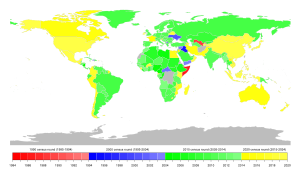
Back Sensus Afrikaans إحصاء السكان Arabic Censu de población AST Халкъалъул хъвай-хъвагӀай AV نۆفوس ساییمی AZB Халыҡ иҫәбен алыу Bashkir Перапіс насельніцтва Byelorussian Перапіс насельніцтва BE-X-OLD Преброяване на населението Bulgarian जनगणना Bihari

A census (from Latin censere, 'to assess') is the procedure of systematically acquiring, recording, and calculating population information about the members of a given population, usually displayed in the form of statistics. This term is used mostly in connection with national population and housing censuses; other common censuses include censuses of agriculture, traditional culture, business, supplies, and traffic censuses. The United Nations (UN) defines the essential features of population and housing censuses as "individual enumeration, universality within a defined territory, simultaneity and defined periodicity", and recommends that population censuses be taken at least every ten years. UN recommendations also cover census topics to be collected, official definitions, classifications, and other useful information to coordinate international practices.[1][2]
The UN's Food and Agriculture Organization (FAO), in turn, defines the census of agriculture as "a statistical operation for collecting, processing and disseminating data on the structure of agriculture, covering the whole or a significant part of a country." "In a census of agriculture, data are collected at the holding level."[3]
The word is of Latin origin: during the Roman Republic, the census was a list of all adult males fit for military service. The modern census is essential to international comparisons of any type of statistics, and censuses collect data on many attributes of a population, not just the number of individuals. Censuses typically began as the only method of collecting national demographic data and are now part of a larger system of different surveys. Although population estimates remain an important function of a census, including exactly the geographic distribution of the population or the agricultural population, statistics can be produced about combinations of attributes, e.g., education by age and sex in different regions. Current administrative data systems allow for other approaches to enumeration with the same level of detail but raise concerns about privacy and the possibility of biasing estimates.[4]
A census can be contrasted with sampling in which information is obtained only from a subset of a population; typically, main population estimates are updated by such intercensal estimates. Modern census data are commonly used for research, business marketing, and planning, and as a baseline for designing sample surveys by providing a sampling frame such as an address register. Census counts are necessary to adjust samples to be representative of a population by weighting them as is common in opinion polling. Similarly, stratification requires knowledge of the relative sizes of different population strata, which can be derived from census enumerations. In some countries, the census provides the official counts used to apportion the number of elected representatives to regions (sometimes controversially – e.g., Utah v. Evans). In many cases, a carefully chosen random sample can provide more accurate information than attempts to get a population census.[5]

- ^ United Nations (2008). Principles and Recommendations for Population and Housing Censuses Archived 2011-05-14 at the Wayback Machine. Statistical Papers: Series M No. 67/Rev. 2. p. 8. ISBN 978-92-1-161505-0.
- ^ "CES 2010 Census Recommendations" (PDF). Unece.org. Archived (PDF) from the original on 2011-10-27. Retrieved 2013-11-19.
- ^ World Programme for the Census of Agriculture 2020 Volume 1: Programme, concepts and definitions. FAO statistical development series No. 15. Rome: FAO. 2015. ISBN 978-92-5-108865-4. Archived from the original on 2020-11-10. Retrieved 2020-11-19.
 Text was copied from this source, which is available under a Creative Commons Attribution 3.0 IGO (CC BY 3.0 IGO) Archived 2019-11-24 at the Wayback Machine license.
Text was copied from this source, which is available under a Creative Commons Attribution 3.0 IGO (CC BY 3.0 IGO) Archived 2019-11-24 at the Wayback Machine license.
- ^ "History and Development of the Census in England and Wales". theforgottenfamily.wordpress.org. 2017-01-19. Archived from the original on 2017-02-02. Retrieved 2017-01-20.
- ^ Salant, Priscilla, and Don A. Dillman. "How to Conduct your Survey: Leading professional give you proven techniques for getting reliable results." (1995)